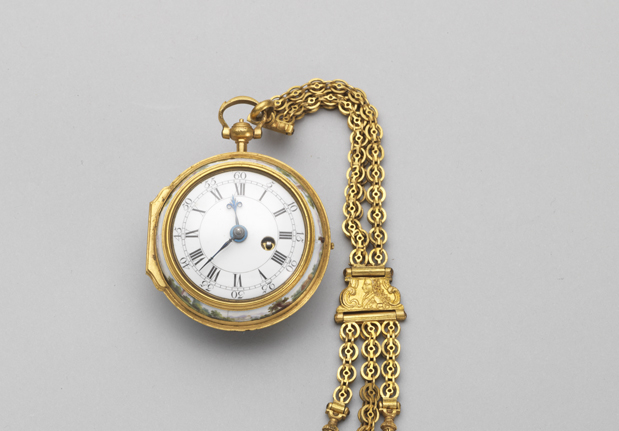Gilt bronze pocket watch with painted enamels, London, 18th century
- Image Number: K1E000813N000000000PAB
- Dynasty: Qing dynasty
- Category: Enamel wares
- Function: Dress accessories
- Material: Minerals/Metals/Copper
- Description:
European mechanical clocks and watches were first introduced to China during the Wanli period of the late Ming Dynasty. A large number of clocks and watches entered the Qing Palace through different ways. Some of them were brought by missionaries and diplomatic envoys when they came to China to publicize the material civilization and scientific achievements of the West, and some of them were bought by local officials in Guangdong and Macao. In the early Qing Dynasty, all kinds of clocks and watches became fashionable articles for the royal family and princes, among which the most popular ones were those decorated with enamel. When Emperor Qianlong saw new and ingenious objects, he ordered court craftsmen to design and make “hundreds of items” boxes and cabinets, which were stored in different palaces. There is a “clock making office” in the Palace of Qing Dynasty. Most of the main craftsmen are Western Jesuits. Under the supervision of the emperor, they made and transformed clocks and watches with great ingenuity. The industrial revolution in Europe in the 18th century made science and technology widely used in various fields. Thanks to the progress of metallurgical technology,

![图片[2]-Gilt bronze pocket watch with painted enamels, London, 18th century-China Archive](https://chinaarchive.net/Qing dynasty/Enamel wares/K1E000813N000000000PAB-63097.jpg)
![图片[3]-Gilt bronze pocket watch with painted enamels, London, 18th century-China Archive](https://chinaarchive.net/Qing dynasty/Enamel wares/K1E000813N000000000PAB-63098.jpg)
![图片[4]-Gilt bronze pocket watch with painted enamels, London, 18th century-China Archive](https://chinaarchive.net/Qing dynasty/Enamel wares/K1E000813N000000000PAB-63099.jpg)
Pictures & Images [HD] download
© Copyright
The copyright of the article belongs to the author, please keep the original link for reprinting.
THE END





![[Qing Dynasty] British female painter—Elizabeth Keith, using woodblock prints to record China from the late Qing Dynasty to the early Republic of China—1915-China Archive](https://chinaarchive.net/wp-content/uploads/2022/11/image-191x300.png)